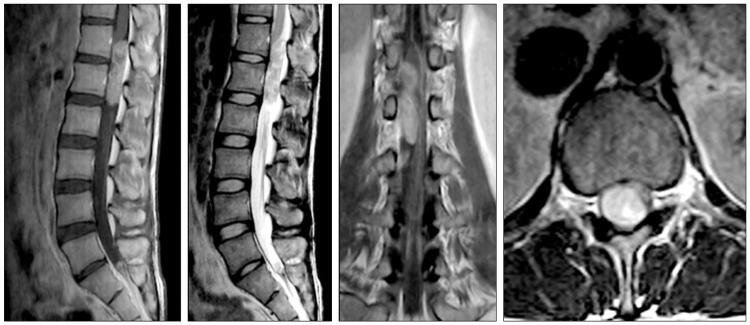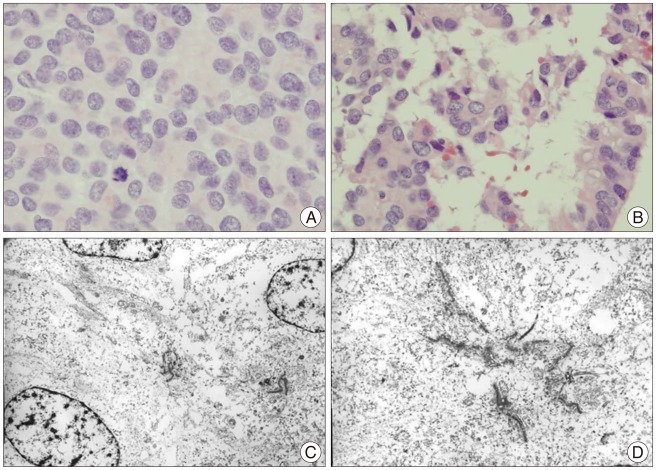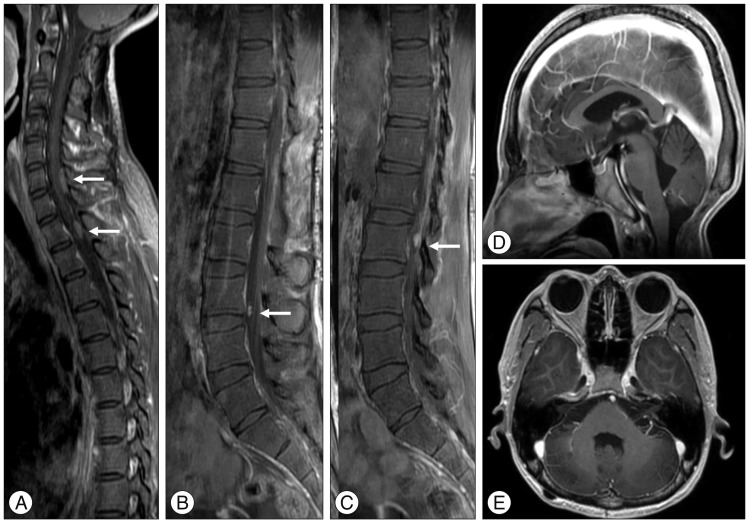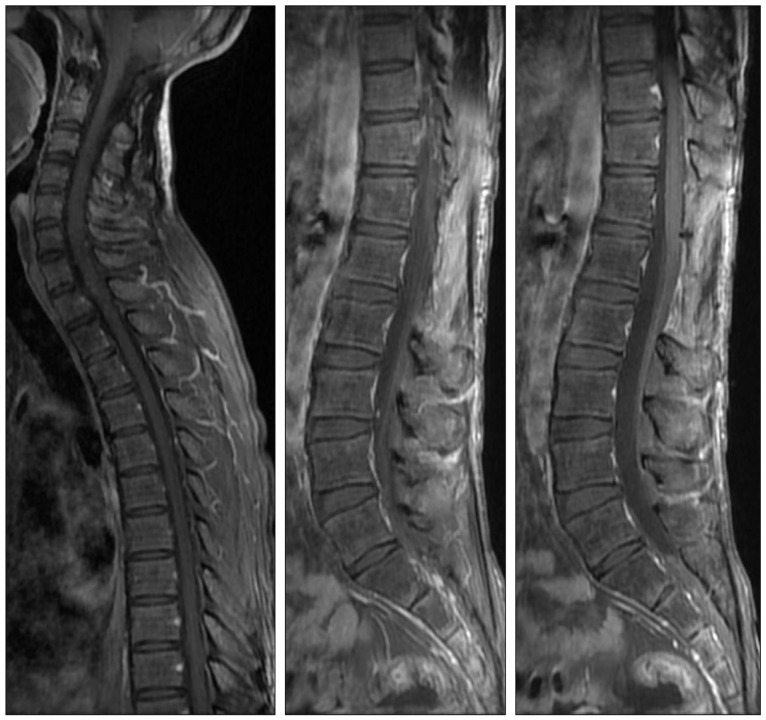J Korean Neurosurg Soc.
2013 Dec;54(6):521-524. 10.3340/jkns.2013.54.6.521.
Multiple Spinal Cord Recurrences of an Intracranial Ependymoma after 14 Years
- Affiliations
-
- 1Department of Radiation Oncology, Konkuk University School of Medicine, Seoul, Korea.
- 2Department of Neurosurgery, Konkuk University School of Medicine, Seoul, Korea. s1nsman@chol.com
- KMID: 2190951
- DOI: http://doi.org/10.3340/jkns.2013.54.6.521
Abstract
- Ependymoma can spread via cerebrospinal fluid, but late spinal recurrences of intracranial tumor are very rare. We describe a case of a 33-year-old male who presented with multiple, delayed, recurrent lesions in the spinal cord from an intracranial ependymoma. The patient underwent gross total resection and postoperative radiation therapy 14 years prior to visit for a low grade ependymoma in the 4th ventricle. The large thoraco-lumbar intradural-extramedullary spinal cord tumor was surgically removed and the pathologic diagnosis was an anaplastic ependymoma. An adjuvant whole-spine radiation therapy for residual spine lesions was performed. After completion of radiation therapy, a MRI showed a near complete response and the disease was stable for three years.
MeSH Terms
Figure
Reference
-
1. Bademci G, Tun K, Erden E, Evliyaoglu C, Unlu A. Late dissemination of ependymoma : case report. Neurocirugia (Astur). 2007; 18:333–336. PMID: 17882342.2. Bortolotto S, Chiadò-Piat L, Cavalla P, Bosone I, Mauro A, Schiffer D. CDKN2A/p16 in ependymomas. J Neurooncol. 2001; 54:9–13. PMID: 11763427.3. Celli P, Cervoni L, Salvati M, Cantore G. Recurrence from filum terminale ependymoma 42 years after 'total' removal and radiotherapy. J Neurooncol. 1997; 34:153–156. PMID: 9210062.4. Chao ST, Kobayashi T, Benzel E, Reddy CA, Stevens GH, Prayson RA, et al. The role of adjuvant radiation therapy in the treatment of spinal myxopapillary ependymomas. J Neurosurg Spine. 2011; 14:59–64. PMID: 21142463.
Article5. Ernestus RI, Schröder R, Stützer H, Klug N. The clinical and prognostic relevance of grading in intracranial ependymomas. Br J Neurosurg. 1997; 11:421–428. PMID: 9474274.
Article6. Good CD, Wade AM, Hayward RD, Phipps KP, Michalski AJ, Harkness WF, et al. Surveillance neuroimaging in childhood intracranial ependymoma : how effective, how often, and for how long? J Neurosurg. 2001; 94:27–32. PMID: 11147894.7. Halvorsen CM, Kolstad F, Hald J, Johannesen TB, Krossnes BK, Langmoen IA, et al. Long-term outcome after resection of intraspinal ependymomas : report of 86 consecutive cases. Neurosurgery. 2010; 67:1622–1631. discussion 1631. PMID: 21107192.
Article8. Iunes EA, Stávale JN, de Cássia Caldas Pessoa R, Ansai R, Onishi FJ, de Paiva Neto MA, et al. Multifocal intradural extramedullary ependymoma. Case report. J Neurosurg Spine. 2011; 14:65–70. PMID: 21142461.9. Kim DG, Cho BK, Yang HJ, Chi JG, Jung HW, Kim HJ, et al. Intracranial Ependymoma : Clinicopathologic Features and Prognostic Factors. J Korean Neurosurg Soc. 1991; 20:893–899.10. Kleihues P, Burger PC, Scheithauer BW, Zülch KJ. Histological typing of tumours of the central nervous system, ed 2. Berlin: Springer-Verlag;1993.11. Lyons MK, Kelly PJ. Posterior fossa ependymomas : report of 30 cases and review of the literature. Neurosurgery. 1991; 28:659–664. discussion 664-665. PMID: 1876243.12. McLaughlin MP, Marcus RB Jr, Buatti JM, McCollough WM, Mickle JP, Kedar A, et al. Ependymoma: results, prognostic factors and treatment recommendations. Int J Radiat Oncol Biol Phys. 1998; 40:845–850. PMID: 9531369.
Article13. Metellus P, Guyotat J, Chinot O, Durand A, Barrie M, Giorgi R, et al. Adult intracranial WHO grade II ependymomas : long-term outcome and prognostic factor analysis in a series of 114 patients. Neuro Oncol. 2010; 12:976–984. PMID: 20484442.
Article14. Nakasu S, Ohashi M, Suzuki F, Matsuda M. Late dissemination of fourth ventricle ependymoma : a case report. J Neurooncol. 2001; 55:117–120. PMID: 11817702.15. Ochiai H, Yamakawa Y, Kawano H, Shimao Y, Hayashi T. Late spinal cord metastasis of fourth ventricle ependymoma appeared nineteen years after the initial treatment. J Neurooncol. 2010; 96:295–299. PMID: 19629395.
Article16. Rehman S, Brock C, Newlands ES. A case report of a recurrent intracranial ependymoma treated with temozolomide in remission 10 years after completing chemotherapy. Am J Clin Oncol. 2006; 29:106–107. PMID: 16462515.
Article17. Rezai AR, Woo HH, Lee M, Cohen H, Zagzag D, Epstein FJ. Disseminated ependymomas of the central nervous system. J Neurosurg. 1996; 85:618–624. PMID: 8814165.
Article18. Salazar OM, Castro-Vita H, VanHoutte P, Rubin P, Aygun C. Improved survival in cases of intracranial ependymoma after radiation therapy. Late report and recommendations. J Neurosurg. 1983; 59:652–659. PMID: 6886786.
Article
- Full Text Links
- Actions
-
Cited
- CITED
-
- Close
- Share
- Similar articles
-
- Myxopapillary Ependymoma of Spinal Cord Conus Medullaris
- A Case of Spinal Cord Ependymoma
- Extensive Leptomeningeal Spreading of Ependymoma in an Adult: Case Report and Literature Review
- Extra and Intramedullary Anaplastic Ependymoma in Thoracic Spinal Cord
- A Case of Intramedullary Ependymoma in the upper Thoracic Spinal Cord





